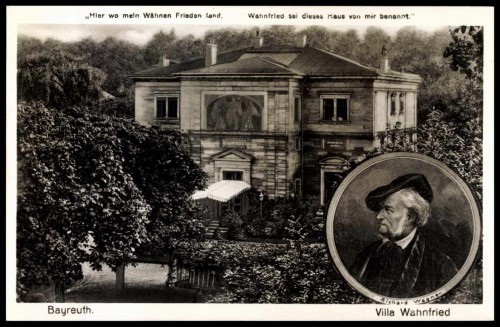Wahnfried was the name given by Richard Wagner to his villa in Bayreuth. The name is a German compound of Wahn (delusion, madness) and Fried(e), (peace, freedom). The house was constructed from 1872 to 1874 under Carl Wölfel’s supervision after plans from Berlin architect Wilhelm Neumann, the plans being altered according to some ideas of Wagner.
The front of the house shows Wagner’s motto “Hier wo mein Wähnen Frieden fand – Wahnfried – sei dieses Haus von mir benannt.” (“Here where my delusions have found peace, let this place be named Wahnfried.”) The house has been a museum since 1976. Visitors can take a walk in the remote Hofgarten, the baroque park of Bayreuth’s New Castle, to where a path directly leads.
1881 (August): Richard Wagner and family at Villa Wahnfried: Above: Blandine von Bulow (1863-1941), Heinrich von Stein (1857-1887, Siegfrieds teacher), Cosima Wagner (1837-1930), Richard Wagner (1813-1883) and the painter Paul von Joukowsky (1845-1912). Down: Isolde Wagner (1865-1919), Daniela von Bulow (1860-1940), Eva Chamberlain-Wagner (1867-1942), Siegfried Wagner (1869-1930).
1882. Richard Wagner and friends in his library. Richard Wagner (1813-1883), Cosima Wagner (1837-1930), Heinrich Freiherr von Stein (1857-1887, Siegfrieds teacher), the painter Paul von Joukowsky (1845-1912) and Richard Wagners’ stepdaughters Daniela von Bulow (1860-1940, daughter of Hans von Bulow (1830-1894) and Cosima Wagner (1837-1930)) and Blandine von Bulow (1863-1941, also daughter of Hans von Bulow (1830-1894) and Cosima Wagner (1837-1930)). Last photo with Richard Wagner. Villa Wahnfried.

1886. Villa Wahnfried.

1945. Villa Wahnfried.




Villa Wahnfried. First floor.

Villa Wahnfried. Backside.
The grave of Richard Wagner and his wife Cosima on the grounds of Wahnfried.



